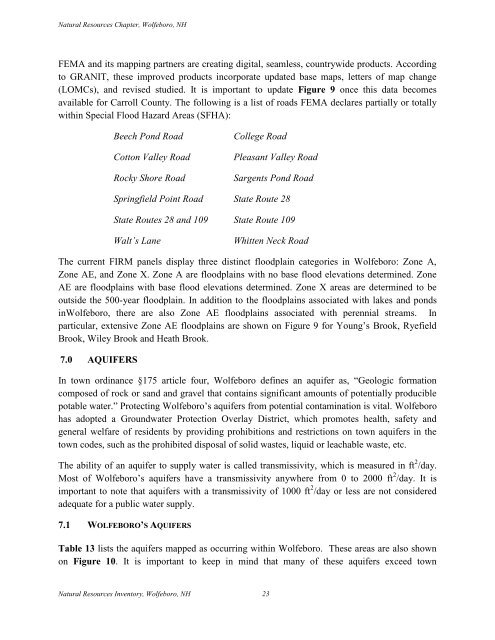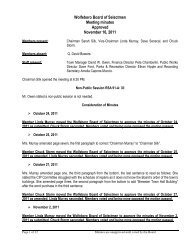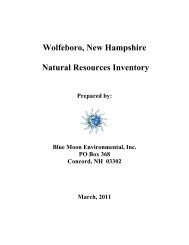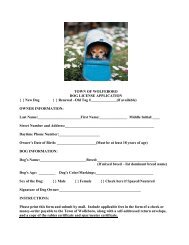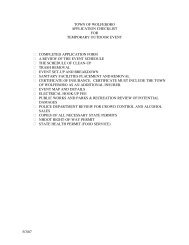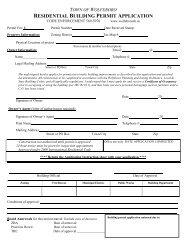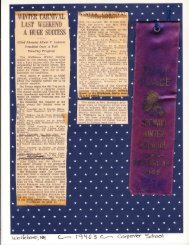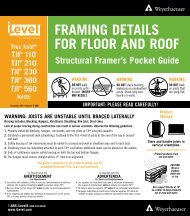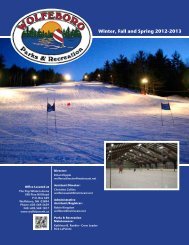Natural Resources Chapter of the Master Plan - Town of Wolfeboro
Natural Resources Chapter of the Master Plan - Town of Wolfeboro
Natural Resources Chapter of the Master Plan - Town of Wolfeboro
You also want an ePaper? Increase the reach of your titles
YUMPU automatically turns print PDFs into web optimized ePapers that Google loves.
<strong>Natural</strong> <strong>Resources</strong> <strong>Chapter</strong>, <strong>Wolfeboro</strong>, NH<br />
FEMA and its mapping partners are creating digital, seamless, countrywide products. According<br />
to GRANIT, <strong>the</strong>se improved products incorporate updated base maps, letters <strong>of</strong> map change<br />
(LOMCs), and revised studied. It is important to update Figure 9 once this data becomes<br />
available for Carroll County. The following is a list <strong>of</strong> roads FEMA declares partially or totally<br />
within Special Flood Hazard Areas (SFHA):<br />
Beech Pond Road<br />
Cotton Valley Road<br />
Rocky Shore Road<br />
College Road<br />
Pleasant Valley Road<br />
Sargents Pond Road<br />
Springfield Point Road State Route 28<br />
State Routes 28 and 109 State Route 109<br />
Walt’s Lane<br />
Whitten Neck Road<br />
The current FIRM panels display three distinct floodplain categories in <strong>Wolfeboro</strong>: Zone A,<br />
Zone AE, and Zone X. Zone A are floodplains with no base flood elevations determined. Zone<br />
AE are floodplains with base flood elevations determined. Zone X areas are determined to be<br />
outside <strong>the</strong> 500-year floodplain. In addition to <strong>the</strong> floodplains associated with lakes and ponds<br />
in<strong>Wolfeboro</strong>, <strong>the</strong>re are also Zone AE floodplains associated with perennial streams. In<br />
particular, extensive Zone AE floodplains are shown on Figure 9 for Young‟s Brook, Ryefield<br />
Brook, Wiley Brook and Heath Brook.<br />
7.0 AQUIFERS<br />
In town ordinance §175 article four, <strong>Wolfeboro</strong> defines an aquifer as, “Geologic formation<br />
composed <strong>of</strong> rock or sand and gravel that contains significant amounts <strong>of</strong> potentially producible<br />
potable water.” Protecting <strong>Wolfeboro</strong>‟s aquifers from potential contamination is vital. <strong>Wolfeboro</strong><br />
has adopted a Groundwater Protection Overlay District, which promotes health, safety and<br />
general welfare <strong>of</strong> residents by providing prohibitions and restrictions on town aquifers in <strong>the</strong><br />
town codes, such as <strong>the</strong> prohibited disposal <strong>of</strong> solid wastes, liquid or leachable waste, etc.<br />
The ability <strong>of</strong> an aquifer to supply water is called transmissivity, which is measured in ft 2 /day.<br />
Most <strong>of</strong> <strong>Wolfeboro</strong>‟s aquifers have a transmissivity anywhere from 0 to 2000 ft 2 /day. It is<br />
important to note that aquifers with a transmissivity <strong>of</strong> 1000 ft 2 /day or less are not considered<br />
adequate for a public water supply.<br />
7.1 WOLFEBORO’S AQUIFERS<br />
Table 13 lists <strong>the</strong> aquifers mapped as occurring within <strong>Wolfeboro</strong>. These areas are also shown<br />
on Figure 10. It is important to keep in mind that many <strong>of</strong> <strong>the</strong>se aquifers exceed town<br />
<strong>Natural</strong> <strong>Resources</strong> Inventory, <strong>Wolfeboro</strong>, NH 23


